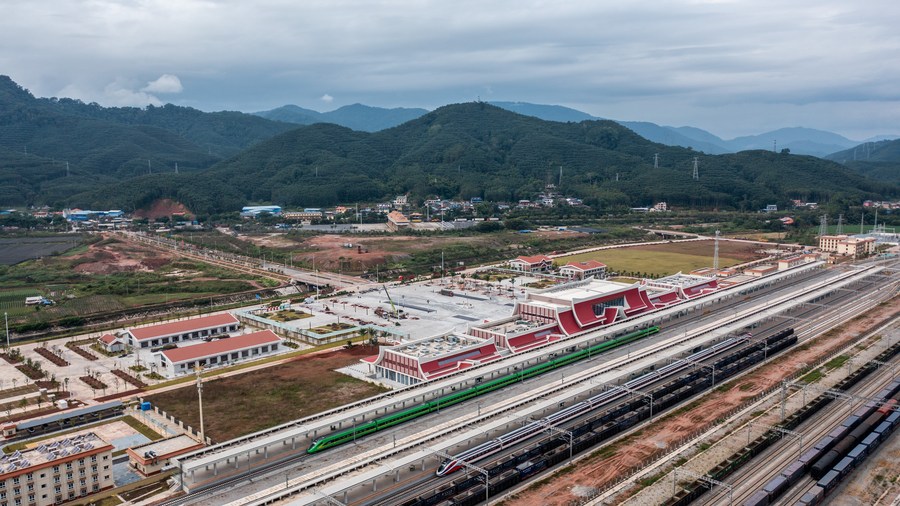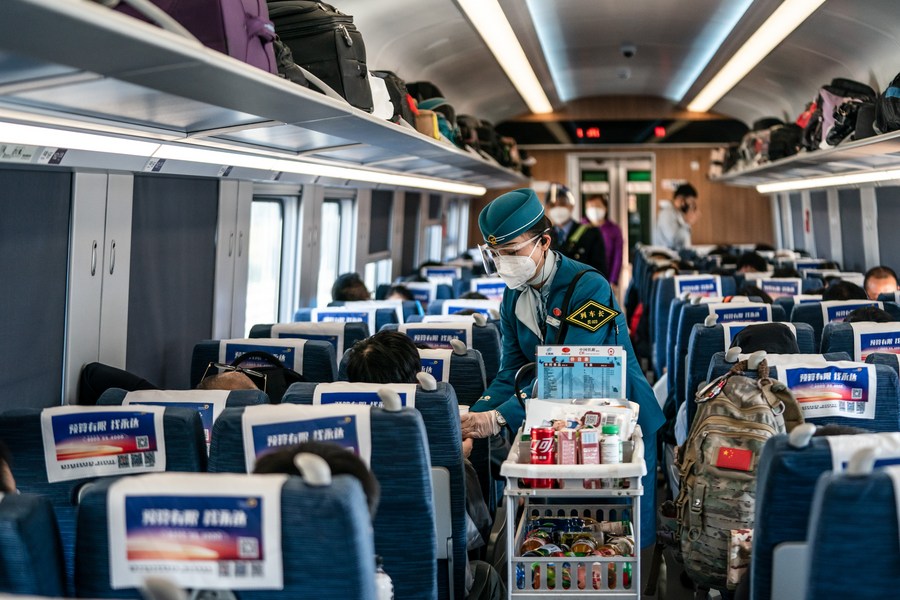




- BRNN
- BRI News
- BRNN News
- Database
Official Documents Polices and Regulations
Inter-government Documents International Cooperation BRI Countries
Business Guide Economic Data BRI Data
Trade
Investment Projects Latest projects
Cases - Content Pool
* Linking Vientiane with Kunming, capital of Yunnan, the 1,035-km railway generates benefits more than just at local levels. In the first 10 months of 2022, 335,794 tourists, accounting for 85.27 percent of the total, arrived in Luang Prabang province by train, with the rest traveling by plane, bus or boat, said the province's Information, Culture and Tourism Department.
* As trade and logistics demand between China and ASEAN countries has increased since the Regional Comprehensive Economic Partnership, the world's biggest free trade deal, took effect on Jan. 1, the railway has worked as an efficient freight channel.
* With its rising volume of passenger and cargo transportation over the past year, the railway has not only benefited the people of both countries, but also become a popular international public product and a platform for international cooperation.
VIENTIANE/KUNMING, Dec. 3 (Xinhua) -- For 32-year-old Kingkeo Duangphanam, who lives in the northern Luang Prabang province of Laos, going to the capital Vientiane in the far south of the country once meant an arduous trek of eight hours, sometimes nine, by bus.
Now it takes only two hours, by rail. Since the opening of the China-Laos Railway, Kingkeo has traveled from her hometown to Vientiane six times, the latest of which she made to take her children to a hospital. She told Xinhua she loves the trip, as it saves time and is comfortable, not as tiring as by bus.
Northwards into China, in Chengzi, a Dai ethnic village adjacent to the rail in southwest China's Yunnan Province, villagers have turned courtyards into hostels and plan to hold folk festivals to attract tourists, eyeing dividends brought by the railway.
Linking Vientiane with Kunming, capital of Yunnan, the 1,035-km railway generates benefits more than just at local levels. With 8.5 million passengers and 11.2 million tons of freight delivered and its cross-border cargo transport covering over 10 countries and regions since its launch one year ago, the railway is a docking project between China's Belt and Road Initiative (BRI) and Laos' strategy to convert itself from a landlocked country to a land-linked hub in the Indo-China Peninsula.
With its rising volume of passenger and cargo transportation over the past year, the railway has not only benefited the people of both countries, but also become a popular international public product and a platform for international cooperation.

This aerial photo taken on Nov. 24, 2022 shows bullet trains at Mohan railway station of the China-Laos Railway in southwest China's Yunnan Province. (Xinhua/Hu Chao)
RAIL-BOOSTED ECONOMY
With only a 3.5-km long railroad to Thailand, the economic development of Laos, the only landlocked country in Southeast Asia, had long been restricted.
Like Kingkeo, Phouttoula Xayyathit from Luang Prabang used to commute to Vientiane for work by car for some 12 hours. With the opening of the China-Laos Railway, the first modern one in Laos, on Dec. 3, 2021, "it only takes about 2 hours by train. I have never felt such convenience," he told Xinhua.
Some 220 km north of Vientiane, the town of Luang Prabang, listed by the United Nations Educational, Scientific and Cultural Organization (UNESCO) as a world heritage in 1995, is a top tourist draw with its old temples and rural landscapes. Since May, it has seen a growing influx of holidaymakers among a surge of visitors to Laos.
In the first 10 months of 2022, 335,794 tourists, accounting for 85.27 percent of the total, arrived in Luang Prabang province by train, with the rest traveling by plane, bus or boat, said the province's Information, Culture and Tourism Department.
Many are from neighboring countries like Thailand, "which promotes the development of tourism and improves the economy of Laotian cities," said Vilaxay Xaylongsy, a station manager at the Vientiane railway station.
The full operation of the China-Laos Railway, scenic Vang Vieng and Luang Prabang, as well as the low value of the Lao currency the kip, are among the main attractions for visitors from neighboring countries, said the latest report by the Tourism Development Department under the Lao Ministry of Information, Culture and Tourism.
Residents by the rail foresee a boom in tourism. Like Chengzi village, which is actively developing rural tourism in the Xishuangbanna Dai Autonomous Prefecture in Yunnan, many once-obscure villages close to the rail in China have gradually become popular destinations.
The railway is the foundation of the village's development, said Ai Hanpeng from Chengzi.
By cutting transport time, the China-Laos Railway has also facilitated trade. "We saved about 30 percent of the logistics cost from Kunming to Vientiane thanks to reduced transportation time and lower freight damage," said Yang Jie, head of the Kunming office of a Shanghai-based supply chain management company.
Enterprises have become more confident about expanding business in Southeast Asia thanks to the railway, said Yang, whose company has branched out in Laos and chartered trains to ship goods from Vientiane to Kunming.
Latest data showed that the cargo carried by the railway has expanded to more than 1,200 categories. The goods shipped from Laos include rubber, barley rice, cassava, coffee, beer, ores and potash, while daily necessities, mechanical parts, auto parts and electronic products are shipped from China, said Du Zhigang, operation director of the Laos-China Railway Co., Ltd. (LCRC), a joint venture based in Vientiane and responsible for the operation of the railway's Lao section.
In the past year, the Lao section has carried 1.3 million passengers and shipped around 2 million tons of goods, most cross-border. "People and enterprises all over the country have benefited from it. It is time-saving and convenient and has driven the Lao economy to a higher level," said Sommad Pholsena, vice president of the Lao National Assembly.

A conductor serves drinking water for a passenger on a train of the China-Laos Railway, Nov. 23, 2022. (Xinhua/Hu Chao)
"HARD LINK" TO "HEART LINK"
The railway ships talents, too.
In 2018, as the Shanghai Institute of Technology teamed up with Laos' Souphanouvong University to launch an educational exchange program, nine Lao students went to Shanghai for undergraduate courses, the first example of China helping nurture technical railway personnel for countries along the Belt and Road.
Two more groups of Lao students were enrolled in 2019 and 2021. Over 20 of those students have so far returned to Laos after graduation, most of whom are working for the China-Laos Railway, and some have become team leaders, while there are also students further studying with their research interest closely related to the railway, said Li Peigang, director of the School of Railway Transportation of the Shanghai Institute of Technology.
More than 700 Lao citizens have been employed in the daily operation of the railway. At the Vientiane station, Pansay Yiayengva, 28, has grown from a rookie to an experienced passenger duty attendant and manager with the help of her mentor, one of her Chinese colleagues.
"We were very touched and grateful to have those Chinese colleagues teaching us," she said. "Laos and China joined hands to build the railway, develop and deepen our friendship, and also developed our economy in Laos." Before entering the LCRC, Pansay spent three years studying business administration in China.
Vilaxay, the station manager, felt the same way. "They (Chinese colleagues) taught us everything," he said. "And they are hardworking -- that's an important thing I learned from my fellow Chinese workers, and they are very sincere friends."
Lao students are also taught how to teach. More than 40 are studying at the Kunming Railway Vocational and Technical College, and will be the first teachers in Laos' first railway vocational and technical college, which China assisted in building.
"To give more Lao people the opportunity to learn railway knowledge, I came to China to study. When I return, I will teach what I've learned to others," said Lao student Weobandid Phonvilai.
When inspecting the Vientiane station in February, Lao President Thongloun Sisoulith said the railway's operation facilitates people-to-people exchanges between the two countries, and the Lao people feel proud of the railway.
Others on the other end of the rail agreed.
"People in Yunnan are very proud of the railway ... Many of them have taken it or plan to take it, and youngsters want to take a trip to Laos," said Li Peigang, who, together with several students, surveyed along the section between Kunming and Mohan, a border town in Yunnan.
"The 'hard link' of railway tracks has strengthened the 'heart link' between the two peoples," said Ma Yong, head of the Institute of Southeast Asian Studies at the Yunnan Academy of Social Sciences.

Containers are reloaded at a freight transit yard of China-Laos Railway's Vientiane South Station on July 1, 2022. (Photo by Kaikeo Saiyasane/Xinhua)
TRANS-ASIA NETWORK
At the Vientiane station, Thanyart Areeyat, a tour guide from Thailand, told Xinhua that "everyone is interested and excited about the China-Laos Railway."
"Thai tourists will also be really interested in taking a bullet train directly to China," said the 28-year-old, who hopes to take a train trip from Laos to China in the near future.
It may not be too long before such a trip is possible, as the construction of the China-Thailand Railway continues apace.
When meeting with Thai Prime Minister Prayut Chan-o-cha last month, visiting Chinese President Xi Jinping said the two sides need to speed up China-Thailand-Laos tripartite railway cooperation, advance the China-Thailand-Laos Connectivity Development Corridor Outlook, strengthen the physical connectivity of infrastructure as a key focus, enhance institutional connectivity in logistics and customs clearance and expand the export of high-quality Thai agricultural and sideline products to China.
When the China-Thailand Railway is completed, it will take trains from the Thai capital of Bangkok to the country's northeastern border town of Nong Khai, where a bridge will connect it with the southern end of the China-Laos Railway.
Analysts said the connection will not only inject vitality into the economy along the line, but strengthen the trans-Asian railway network and promote regional connectivity.
An artery running through the Indo-China Peninsula will be formed, which will further promote economy, trade and investment and boost common prosperity when linked to the China-Europe freight train network and with closer cooperation under the BRI, said Wirun Phichaiwongphakdee, director of the Thailand-China Research Center of the Belt and Road Initiative, who went to Laos in October to conduct research into the China-Laos Railway.
Wirun said he hopes that the construction of the China-Thailand Railway, Thailand's first standard-gauge high-speed railway, could speed up.
At its northern end in Kunming, the China-Laos Railway has been connected with the China-Europe freight train network and China's New International Land-Sea Trade Corridor, a trade and logistics passage jointly built by provincial-level regions in western China and ASEAN members.
So far, 25 provincial-level regions in China have operated international freight trains on the railway, and freight transportation has covered countries and regions including Laos, Thailand, Myanmar, Malaysia, Cambodia and Singapore.
As trade and logistics demand between China and ASEAN countries has increased since the Regional Comprehensive Economic Partnership, the world's biggest free trade deal, took effect on Jan. 1, the railway has worked as an efficient freight channel.
For Laos, "the railway could make the country more attractive as an investment destination and link it to major production and consumption areas in China and ASEAN, allowing firms to access global value chains," the World Bank said in 2020.
Just as Xi recently said when meeting with Thongloun, the China-Laos Railway has contributed to the well-being of the two peoples and set a good example for joint Belt and Road construction.

Tel:86-10-65368972, 86-10-65369967